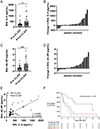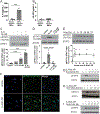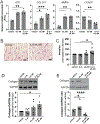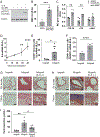Interleukin 6 trans-signaling is a critical driver of lung allograft fibrosis
- PMID: 33249747
- PMCID: PMC8809084
- DOI: 10.1111/ajt.16417
Interleukin 6 trans-signaling is a critical driver of lung allograft fibrosis
Abstract
Histopathologic examination of lungs afflicted by chronic lung allograft dysfunction (CLAD) consistently shows both mononuclear cell (MNC) inflammation and mesenchymal cell (MC) fibroproliferation. We hypothesize that interleukin 6 (IL-6) trans-signaling may be a critical mediator of MNC-MC crosstalk and necessary for the pathogenesis of CLAD. Bronchoalveolar lavage (BAL) fluid obtained after the diagnosis of CLAD has approximately twofold higher IL-6 and soluble IL-6 receptor (sIL-6R) levels compared to matched pre-CLAD samples. Human BAL-derived MCs do not respond to treatment with IL-6 alone but have rapid and prolonged JAK2-mediated STAT3 Tyr705 phosphorylation when exposed to the combination of IL-6 and sIL-6R. STAT3 phosphorylation within MCs upregulates numerous genes causing increased invasion and fibrotic differentiation. MNC, a key source of both IL-6 and sIL-6R, produce minimal amounts of these proteins at baseline but significantly upregulate production when cocultured with MCs. Finally, the use of an IL-6 deficient recipient in a murine orthotopic transplant model of CLAD reduces allograft fibrosis by over 50%. Taken together these results support a mechanism where infiltrating MNCs are stimulated by resident MCs to release large quantities of IL-6 and sIL-6R which then feedback onto the MCs to increase invasion and fibrotic differentiation.
Keywords: animal models: murine; basic (laboratory) research / science; bronchiolitis obliterans (BOS); cellular biology; cytokines / cytokine receptors; fibrosis; lung transplantation / pulmonology; translational research / science.
© 2020 The American Society of Transplantation and the American Society of Transplant Surgeons.
Conflict of interest statement
DISCLOSURE
The authors of this manuscript have no conflicts of interest to disclose as described by the
Figures





Similar articles
-
Spectrum of chronic lung allograft pathology in a mouse minor-mismatched orthotopic lung transplant model.Am J Transplant. 2019 Jan;19(1):247-258. doi: 10.1111/ajt.15167. Epub 2018 Nov 29. Am J Transplant. 2019. PMID: 30378739
-
The role of recipient derived interleukin-17A in a murine orthotopic lung transplant model of restrictive chronic lung allograft dysfunction.Transpl Immunol. 2016 Nov;39:10-17. doi: 10.1016/j.trim.2016.10.001. Epub 2016 Oct 11. Transpl Immunol. 2016. PMID: 27737799
-
Fibroproliferation in chronic lung allograft dysfunction: Association of mesenchymal cells in bronchoalveolar lavage with phenotypes and survival.J Heart Lung Transplant. 2020 Aug;39(8):815-823. doi: 10.1016/j.healun.2020.04.011. Epub 2020 Apr 19. J Heart Lung Transplant. 2020. PMID: 32360292 Free PMC article.
-
The potential of biomarkers of fibrosis in chronic lung allograft dysfunction.Transplant Rev (Orlando). 2021 Jul;35(3):100626. doi: 10.1016/j.trre.2021.100626. Epub 2021 May 4. Transplant Rev (Orlando). 2021. PMID: 33992914 Review.
-
When tissue is the issue: A histological review of chronic lung allograft dysfunction.Am J Transplant. 2020 Oct;20(10):2644-2651. doi: 10.1111/ajt.15864. Epub 2020 Apr 15. Am J Transplant. 2020. PMID: 32185874 Review.
Cited by
-
Dysregulated Cell-Cell Communication Characterizes Pulmonary Fibrosis.Cells. 2022 Oct 21;11(20):3319. doi: 10.3390/cells11203319. Cells. 2022. PMID: 36291184 Free PMC article.
-
The Role of IL-6 in Fibrotic Diseases: Molecular and Cellular Mechanisms.Int J Biol Sci. 2022 Aug 29;18(14):5405-5414. doi: 10.7150/ijbs.75876. eCollection 2022. Int J Biol Sci. 2022. PMID: 36147459 Free PMC article. Review.
-
Interleukin receptor therapeutics attenuate inflammation in canine synovium following cruciate ligament injury.Osteoarthritis Cartilage. 2024 Oct;32(10):1295-1307. doi: 10.1016/j.joca.2024.06.010. Epub 2024 Jul 14. Osteoarthritis Cartilage. 2024. PMID: 39004209
-
Fibrotic progression from acute cellular rejection is dependent on secondary lymphoid organs in a mouse model of chronic lung allograft dysfunction.Am J Transplant. 2024 Jun;24(6):944-953. doi: 10.1016/j.ajt.2024.02.020. Epub 2024 Feb 23. Am J Transplant. 2024. PMID: 38403187 Free PMC article.
-
Novel approaches for long-term lung transplant survival.Front Immunol. 2022 Jul 27;13:931251. doi: 10.3389/fimmu.2022.931251. eCollection 2022. Front Immunol. 2022. PMID: 35967365 Free PMC article. Review.
References
-
- Verleden GM, Glanville AR, Lease ED, Fisher AJ, Calabrese F, Corris PA et al. Chronic lung allograft dysfunction: Definition, diagnostic criteria, and approaches to treatment-A consensus report from the Pulmonary Council of the ISHLT. J Heart Lung Transplant 2019;38(5):493–503. - PubMed
-
- von der Thusen JH, Vandermeulen E, Vos R, Weynand B, Verbeken EK, Verleden SE. The histomorphological spectrum of restrictive chronic lung allograft dysfunction and implications for prognosis. Mod Pathol 2018;31(5):780–790. - PubMed
-
- Martinu T, Howell DN, Davis RD, Steele MP, Palmer SM. Pathologic correlates of bronchiolitis obliterans syndrome in pulmonary retransplant recipients. Chest 2006;129(4):1016–1023. - PubMed
-
- Heng D, Sharples LD, McNeil K, Stewart S, Wreghitt T, Wallwork J. Bronchiolitis obliterans syndrome: incidence, natural history, prognosis, and risk factors. J Heart Lung Transplant 1998;17(12):1255–1263. - PubMed
-
- Sharples LD, McNeil K, Stewart S, Wallwork J. Risk factors for bronchiolitis obliterans: a systematic review of recent publications. J Heart Lung Transplant 2002;21(2):271–281. - PubMed
Publication types
MeSH terms
Substances
Grants and funding
LinkOut - more resources
Full Text Sources
Other Literature Sources
Medical
Molecular Biology Databases
Miscellaneous

